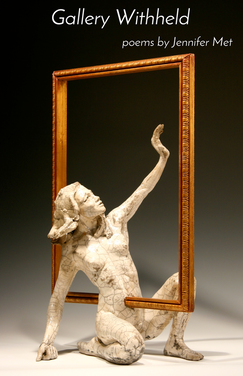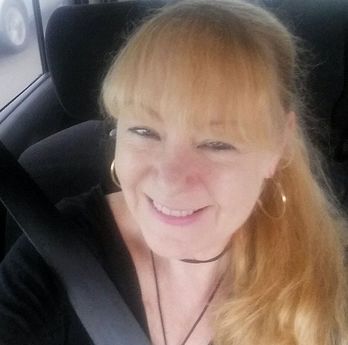Review | Gallery Withheld by Jennifer Met
by Eileen Murphy
One day, enjoying nature and
hunting with my father, the light waning
weary, trudging, coming to a natural
close, we walk resigned
to twilight, and
we chance
upon
a
deer--
hunting with my father, the light waning
weary, trudging, coming to a natural
close, we walk resigned
to twilight, and
we chance
upon
a
deer--
(“Seeking Ekphrasis”)

Doesn’t this excerpt look on the page like a deer’s head—seen straight on? The new poetry chapbook Gallery Withheld by Jennifer Met from Glass Poetry Press offers extraordinary poems married to fantastic shapes on the page, an adventure in poetry that also has visual appeal. To write good poems like these is a balancing act: the poet must first start with an awesome poem (if the poem is mediocre, visuals won’t improve it), come up with a pleasing shape for the poem on the page (and maybe this happens first), and somehow ensure that the shape enhances, rather than detracts from the poem. Jennifer Met’s Gallery Withheld can be recommended for a thrilling, unique reading experience, containing successful poems that also act as visual art.
Jennifer Met is an excellent poet. She’s been nominated for two Pushcart prizes and has won awards for poetry (her poetry awards include awards for haiku), short fiction, and nonfiction. The poems in this chapbook are reader-friendly, atmospheric, and full of imagery. For example, “Coming of Age in Idaho” offers us insight into the speaker’s father as he finds bones which look like “sticks sticking from the verdigris moss”: “—what animal is this? Was this—the bones are small—a fawn’s—.“ What does the father do? He “then buries the bones—and as he does he invents the baby deer’s life.” Another poem in this chapbook that stands out is “Seeking Ekphrasis,” where the speaker’s father and a deer—this time, a doe—play important roles. Speaking of the doe, the speaker remarks: “What ears! Of course she / heard us coming, trundling with / heavy, elephant feet through the brush.” And who can resist a poem that’s in the shape of a Rorschach test ink blot that starts: “8/8/15 8/18/15 / Myself Myself / A butterfly made of nightgowns A butterfly made of tin cans”?
The shapes of the poems created by Jennifer Met are gorgeous. Gallery Withheld offers poems in shapes so clever, it’s almost surreal. There are poems that look like part of a fence toppled by an earthquake (“Collaboration”), a big arrow (“I’m with Stupid”), an upside down beer bottle (“Crawling: The Irony in a Phallic Representation”), and an exclamation point and question mark (“A Wash or a Study in the Inevitability of Gendered Thought”), and more.
This chapbook set me wondering why more poets don’t make shapes of their poems on the page to enhance the reader’s experience. Accordingly, I thought I’d make one of my own poems into the shape of a knife using Microsoft Word, as Jennifer Met told me she used. Well, I tried. And the answer to why more poets don’t do this is because it’s very hard. Trying to make a specially-shaped poem, I discovered words have personalities, they shift-shape and shimmy, they do much more than transmit a thought. In brief, they don’t always cooperate—it’s like herding cats. The writer has to fight them, corral them, and give them necessary space. So, hats off to Jennifer Met for her mastery of this difficult form of poetry art.
I enjoyed reading Gallery Withheld by Jennifer Met (several times). I liked the poems and I liked seeing the images they made on the page. This chapbook is an example of what poetry can be when we consider that a poem’s appearance can often mean as much as the words themselves. Too few writers of poetry are talented enough or wise enough to use all of the tools in their box. They either forget or ignore how a poems looks on the page. Even the blank spaces where nothing (and so much) is said can affect the reader’s understanding and enjoyment of a particular piece. Poems, by definition, are usually short and powerful pieces of writing. Expanding them visually makes them even more so. If a person wants a fully-enhanced reading experience, this poetry delivers—multiple times. Try it—you’ll like it!
Connections:
Gallery Withheld can be purchased at this link: Glass Poetry Press Chapbooks
Jennifer Met is an excellent poet. She’s been nominated for two Pushcart prizes and has won awards for poetry (her poetry awards include awards for haiku), short fiction, and nonfiction. The poems in this chapbook are reader-friendly, atmospheric, and full of imagery. For example, “Coming of Age in Idaho” offers us insight into the speaker’s father as he finds bones which look like “sticks sticking from the verdigris moss”: “—what animal is this? Was this—the bones are small—a fawn’s—.“ What does the father do? He “then buries the bones—and as he does he invents the baby deer’s life.” Another poem in this chapbook that stands out is “Seeking Ekphrasis,” where the speaker’s father and a deer—this time, a doe—play important roles. Speaking of the doe, the speaker remarks: “What ears! Of course she / heard us coming, trundling with / heavy, elephant feet through the brush.” And who can resist a poem that’s in the shape of a Rorschach test ink blot that starts: “8/8/15 8/18/15 / Myself Myself / A butterfly made of nightgowns A butterfly made of tin cans”?
The shapes of the poems created by Jennifer Met are gorgeous. Gallery Withheld offers poems in shapes so clever, it’s almost surreal. There are poems that look like part of a fence toppled by an earthquake (“Collaboration”), a big arrow (“I’m with Stupid”), an upside down beer bottle (“Crawling: The Irony in a Phallic Representation”), and an exclamation point and question mark (“A Wash or a Study in the Inevitability of Gendered Thought”), and more.
This chapbook set me wondering why more poets don’t make shapes of their poems on the page to enhance the reader’s experience. Accordingly, I thought I’d make one of my own poems into the shape of a knife using Microsoft Word, as Jennifer Met told me she used. Well, I tried. And the answer to why more poets don’t do this is because it’s very hard. Trying to make a specially-shaped poem, I discovered words have personalities, they shift-shape and shimmy, they do much more than transmit a thought. In brief, they don’t always cooperate—it’s like herding cats. The writer has to fight them, corral them, and give them necessary space. So, hats off to Jennifer Met for her mastery of this difficult form of poetry art.
I enjoyed reading Gallery Withheld by Jennifer Met (several times). I liked the poems and I liked seeing the images they made on the page. This chapbook is an example of what poetry can be when we consider that a poem’s appearance can often mean as much as the words themselves. Too few writers of poetry are talented enough or wise enough to use all of the tools in their box. They either forget or ignore how a poems looks on the page. Even the blank spaces where nothing (and so much) is said can affect the reader’s understanding and enjoyment of a particular piece. Poems, by definition, are usually short and powerful pieces of writing. Expanding them visually makes them even more so. If a person wants a fully-enhanced reading experience, this poetry delivers—multiple times. Try it—you’ll like it!
Connections:
Gallery Withheld can be purchased at this link: Glass Poetry Press Chapbooks
Eileen MurphyEileen Murphy lives 30 miles from Tampa with her husband and two dogs. She received her Masters degree from Columbia College, Chicago. She teaches literature/English at Polk State College in Lakeland, writes poetry, and has published book reviews in BLARB, Rain Taxi, Tinderbox, and a number of other journals. She is a staff writer for Los Angeles-based Cultural Weekly. She is also a visual artist.
W // Mishmurphy.com |

